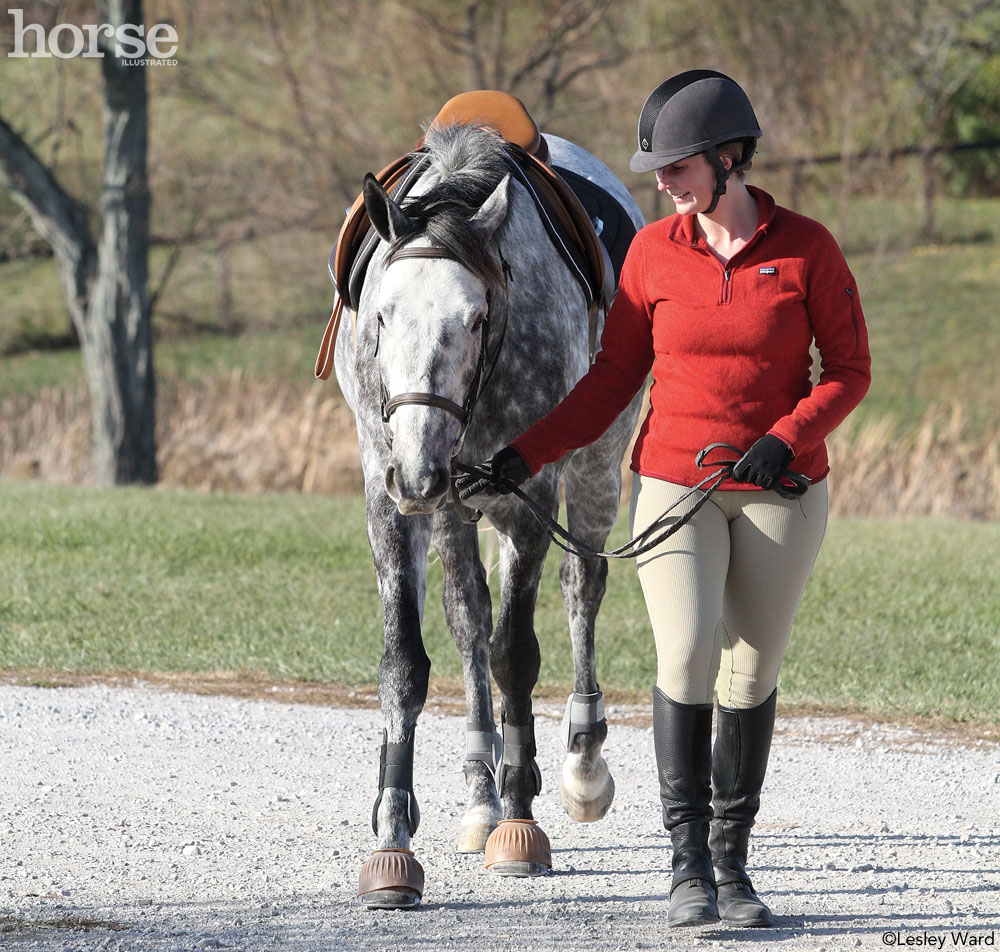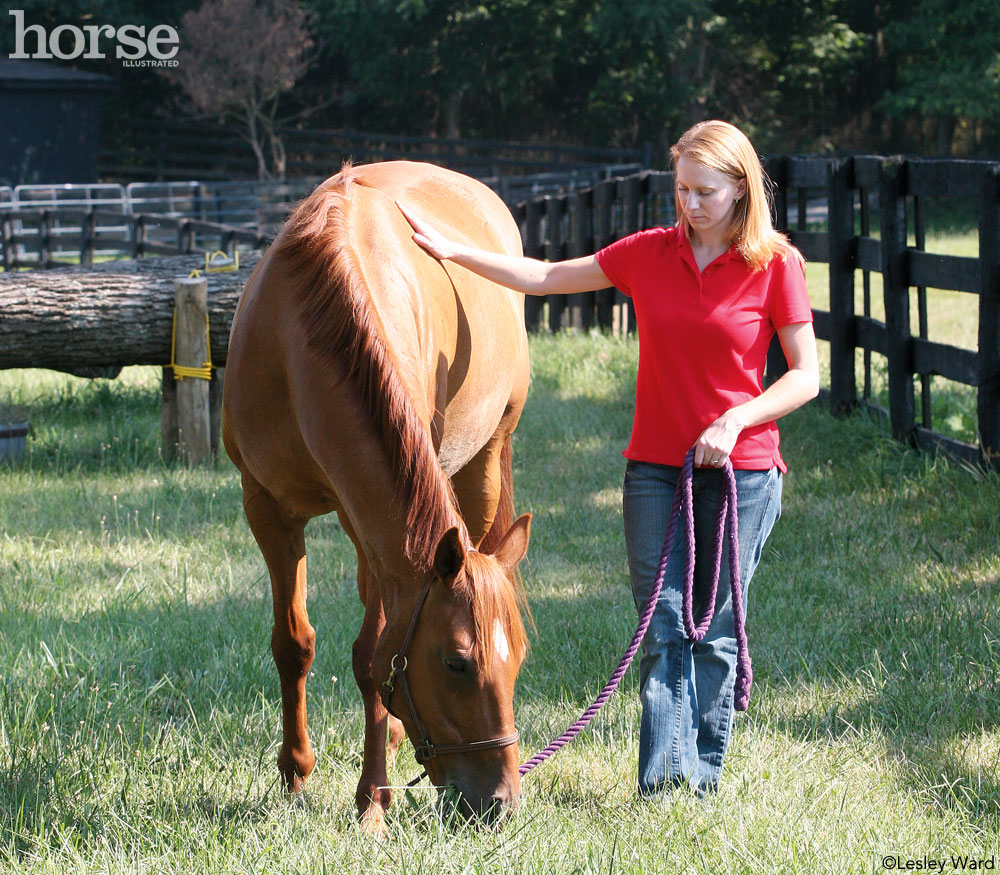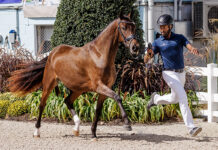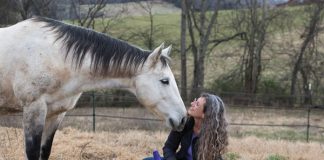So you’ve brought your new horse home. Now what? You want to bond with him, but how do you go about doing it?
Some horses change homes frequently, moving from boarding barn to boarding barn, spending time on the show circuit, or perhaps being sold every few years. Other horses may have been born, brought up, trained and ridden only on their home farm, and may be anxious and apprehensive in a new environment. It is both practical and kind to allow your new horse at least one month of adjustment time for each year that he spent in his previous home. Give him time to relax and accept that your farm is now his home and you are now his person.

History and Context
Bonding with your horse will be easier for you if you’re familiar with his history, so learn as much as you can about his past. Ideally, you’ll be able to discover just how he was handled and managed, what his environment was like, and what his previous owner expected from him.
How does your horse’s new home compare to his old one? Many behavior problems are really just a horse’s natural reactions to major changes in his environment and management. If a horse goes from living in a pasture and eating grass to living in a stall and eating rich hay and high-octane grain, or if his activity schedule goes from occasional, casual trail rides to daily, focused work in an arena, you’re likely to observe some changes (possibly unpleasant) in his attitude. If you’re able to recognize and identify the origin of a problem, you can usually solve it more easily.
Sweet horses can become much less sweet if they are overfed, under- or overexercised, or lonely. Many a rider has said, “My new horse isn’t kind and gentle anymore; he’s getting mean. I don’t think he likes me!” The truth may be that he’s simply overwhelmed by his new environment.
It’s important to be aware that horses are prey animals—timid, apprehensive and easily startled. Good riders and trainers never forget this, and make it a point to work with, not against, the horse’s nature.
Which is better for bonding: grooming or treats?
Safety First!
There are obvious safety procedures to follow around horses, such as wearing a proper riding helmet and boots, and never wrapping the lead rope or reins around your hand. And then there are other, more subtle safety precautions that are just as important. Understanding and respecting equine nature is one of them. If you’re paying close attention to your horse at all times, he is much less likely to surprise you. If you surprise or startle him, he is likely to react defensively; he may jump forward or sideways, fling his head, pull away, back up, rear, or kick. These actions can be terribly dangerous to someone who is in the wrong place and/or not paying attention. Even the kindest, gentlest horse is bigger, heavier, stronger and much faster than the most athletic human.
The more accurately you can read your horse’s behavior and body language, and the more attentive you are, the safer you will be—and the better you will be able to communicate with your horse.
Promoting the Bonding Process
Of course, you’ll spend quality time with your horse, but also spend quantity time with him. Hand-walking and hand-grazing your horse will help the two of you build your relationship. These slow, quiet, low-key activities will allow you to observe him over time. You will become familiar with his habits and reactions; he will become accustomed to your voice, movements, actions and reactions. Grooming sessions will teach him that you’re a source of pleasure and relaxation. You’ll learn his preferences (light strokes with a soft brush or firm strokes with a scratchy brush?) and identify his itchy spots. All of this will help you become friends.
Be Your Horse’s Friend
You’ve undoubtedly heard this before: “If you want a friend, be a friend.” To become your horse’s friend, begin by moving slowly and speaking softly. Your slow, steady movements and quiet voice will help your horse to relax around you; loud noises and sudden movements will have the opposite effect. When in doubt, be even quieter and slower.
You want your horse to be well-behaved, responsive, consistent, trustworthy and affectionate. Horses need to respect and trust their owners before they can relax enough to develop affection for them. If you are calm, and your own behavior and communication are consistent—patient, quick to praise, and always willing to try again—you will build your horse’s trust. As a result, he will quickly develop a positive, relaxed attitude toward learning. Remember, your goal is to build a strong relationship; you’re training for tomorrow and next year and five or 10 years from now.

Hang out with your horse just hand-grazing him for bonding time.
Leadership vs. Friendship
It’s important for you to become your horse’s trusted leader. Naturally you want to be his friend, as well, but leadership must come first; it’s essential for your horse’s emotional security and your own safety. From the very beginning, show your horse that you are a calm, authoritative source of security and comfort. Your leadership will create a foundation for friendship.
Understanding the roles of you and the horse as leader and follower will promote more rapid bonding. You can also save time by avoiding two very common new-horse-owner errors:
- Your new horse is a unique individual; beware of basing your expectations on experiences and habits you developed with a previous horse. Some owners are so familiar with a previous horse that they expect their new horse to have identical understanding, reactions and habits.
- Beware of overfeeding your new horse or constantly offering treats in an effort to bond as quickly as possible. Overfeeding can create attitude and health problems; too many treats can create misunderstandings. Constant treat-feeding can undermine your leadership without actually promoting friendship. Horses quickly learn to expect and demand treats; when that happens, their focus is on the treats, not on you. Yes, your new horse will probably whinny whenever he sees you, but that whinny won’t mean, “I love you!” It will mean, “Hey! Give me my treat!”
There’s nothing wrong with giving your horse an occasional treat, but bonding is not treat-dependent. Watch horses interacting within a herd or group: It’s obvious that respect, trust and friendship exist among horses, but you won’t see any horse offer another horse a treat.
The Training Connection
As you get to know your horse, let him show you what he knows, understands and expects. Avoid making assumptions about what he should know, and don’t rely on the descriptions provided by others, including his previous owner. One person’s definition of well-trained may be another person’s definition of barely started.
A horse that has performed an action once or twice is not trained to perform that action reliably, consistently, or under all circumstances. Learning is a process, and your horse needs to understand what you want, achieve it (often through trial and error), get clear reinforcement from you, and then be encouraged to repeat and refine the action hundreds and thousands of times (but only four or five times per session to avoid over-drilling) before you can count on him to provide the desired response instantly and reliably.
Manners, Habits and Safety
Whenever you approach and handle your new horse, be sure that your expectations are realistic and fair. Ask yourself whether what you’re requesting of your new horse right now is reasonable. Check your own behavior too; your habits can help or hinder the bonding process.
Many horse owners become casual, even careless, with horses they know well, and develop habits that cause them to get into trouble with their new horses. Perhaps your previous horse was so laid-back that you could walk him from barn to pasture with just one finger hooked in his mane. You may need to relearn certain behaviors and develop better, safer habits. Lead your new horse correctly, with a halter and lead rope.
Skills and Styles Checklist
For both your sakes, create a checklist to help you determine what your new horse knows and whether you want him to learn to do things in another way.
Some important skills to check off:
- Leading, stopping, standing, backing, turning.
- Picking up his feet readily when you ask (and not leaning on you while you clean them).
- Tying and cross-tying (ask his previous owner if he has a problem with either).
- Standing quietly when you mount and dismount.
As you get to know one another better, you can reinforce, shape or change his habits. This practice will promote safety and better bonding, as it will help you avoid misunderstandings and inappropriate reactions on both sides. If you are mounting your horse and he moves off before you’ve settled into the saddle, don’t assume that he’s deliberately disobeying or challenging you. His previous owner might not have cared if the horse moved off before being asked.
Whenever your horse’s action, reaction or understanding fails to match your own expectations, gently teach him what you want. Get his attention, make yourself clear, and give him time to understand, time to act, and time to appreciate the praise you offer for even the tiniest try.
You may feel a bit silly teaching your horse things he already knows, but do it anyway. You’ll be accomplishing something important: teaching him exactly how you want him to do something.
Time Out
Training isn’t always smooth. If you feel your own frustration building, you can be sure that your horse is frustrated too. Call a “time out” for both of you. Even a few minutes will allow you both to calm down and relax before you resume work. Horse training involves many repetitions and do-overs; time out is just another part of good training.
Getting Help
We can all benefit from some expert help on occasion. If you don’t already have access to a good local instructor or trainer, take some time to go shopping for a helpful professional. Advertising can be inaccurate, so go in person and observe your potential advisors in action. If your reaction is that the horses all seemed relaxed and happy to cooperate with the pro, that’s good. If it’s, “Wow, that guy can beat any horse into submission,” keep looking. Some people talk the talk well but don’t walk the walk.
Ideally, the trainer’s words and actions will match. If there’s a mismatch, ignore what you hear and believe what you see. As a good horse owner, you have a duty to protect your horse from anyone whose “training” involves violence, fear, pain, or exhausting the horse. Remember, you will still be working with your horse long after that trainer leaves, so don’t permit any actions that will interfere with your own, long-term training and bonding efforts. In true horsemanship, there are no shortcuts, so never be afraid to take your time.
Genuine bonding takes time. Use that time to teach your horse gently and kindly; this will promote the sort of bonding that becomes steadily stronger over your lifetime together.
Jessica Jahiel, Ph.D., is an award-winning author whose books include The Horse Training Problem Solver, The Rider’s Problem Solver, and The Horse Behavior Problem Solver. For more than 40 years, she has been dedicated to helping horses and their riders as an instructor, clinician, and consultant. Jahiel is a member of the Advisory Board of HARPS (Hooved Animal Rescue and Protection Society) and of the Board of Directors at EMSA (Equestrian Medical Safety Association). www.jessicajahiel.com and www.horse-sense.org
This article originally appeared in the 2015 edition of Your New Horse.






